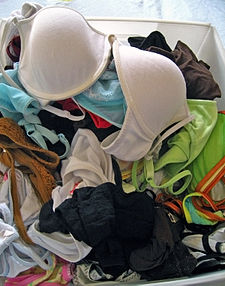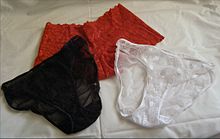- Lingerie
-
For other uses, see Lingerie (disambiguation).
Lingerie (UK: /ˈlændʒ.ər.i/, US: /ˌlɑːndʒ.əˈreɪ/) is a term for fashionable and possibly alluring undergarments. The term in the French language (French pronunciation: [lɛ̃.ʒʁi]) applies to all undergarments for either gender. In English it is applied specifically to those undergarments designed to be visually appealing or erotic. Lingerie usually incorporates one or more flexible, stretchy materials like Lycra, nylon (nylon tricot), polyester, satin, lace, silk and sheer fabric which are not typically used in more functional, basic cotton undergarments.
Contents
Etymology
The word derives from the French word linge, "washables"—as in faire le linge, "do the laundry"—and ultimately from lin for washable linen, the fabric from which European undergarments were made before the general introduction of cotton from Egypt and then from India. It is commonly pronounced in English with a faux French pronunciation, such as /ˈlɒnʒəriː/ in Britain or /lɒnʒərˈeɪ/ in the doubly non-French American pronunciation. The true French pronunciation is [lɛ̃ʒʁi].
Origins
The concept of lingerie as a visually appealing undergarment was developed during the late nineteenth century. Lady Duff-Gordon of Lucile was a pioneer in developing lingerie that freed women from more restrictive corsets. Through the first half of the 20th century, women wore underwear for three primary reasons: to alter their outward shape (first with corsets and later with girdles or bras), for hygienic reasons, or for modesty. Before the invention of crinoline, women's underwear was often very large and bulky. During the late 19th century, corsets became smaller, less bulky and constricting, and were gradually supplanted by the brassiere, first patented in the 20th century by Mary Phelps Jacob. When the First World War broke out, women found themselves filling in men's work roles, creating a demand for more practical undergarments. Manufacturers began to use lighter and more breathable fabrics.[1]
As the 20th century progressed, underwear became smaller and more form fitting. In the 1960s, lingerie manufacturers such as Frederick's of Hollywood begin to glamorize lingerie.[1] The lingerie industry expanded in the 21st century with designs that doubled as outerwear. The French refer to this as 'dessous-dessus' which basically means innerwear as outerwear.
Market structure
The lingerie market at the turn of 21st century was driven by the advent of modern technologies and fabrics that help in designing innovative products such as laser-cut seamless bras and moulded T-shirt bras. Designers are putting greater emphasis on rich-looking fabrics, laces, embroideries and brighter, more daring colors.
The global lingerie market in 2003 was estimated at $29 billion.[2] Bras accounted for 56 per cent while briefs represented 29 per cent of the lingerie market in 2005.[3] The world’s largest lingerie manufacturer, Victoria's Secret, operates almost exclusively in North America. The European market is quite fragmented, with Triumph International and DB Apparel leading the market.[4]
Since the mid-1990s, women have had more choice in bra sizes; the focus has changed from choosing bras in an average size to wearing bras that actually fit perfectly. In the UK, for instance, the media is fueling an awareness campaign about the need for each woman to have a proper bra fitting before every purchase.
Typology
- Babydoll, a short nightgown, or negligee intended as nightwear for women.
- Basque, a tight, form-fitting bodice or coat
- Bedjacket, worn over a nightgown or negligee for warmth and modesty.
- Bikini
- Blanket sleeper
- Bloomers, underpants with short legs.
- Bodystocking, a unitard.
- Bodysuit, a leotard-like undergarment, usually skintight or formfitting.
- Bodice, covers the body from the neck to the waist.
- Boy shorts, a style of panties, so named for their resemblance to male shorts.
- Brassiere
- Bustier
- Camisole, sleeveless and covering the top part of the body
- Camiknickers, camisole and knickers joined as one garment
- Cami shorts
- Cheeky, exposes the bottom part of the buttocks
- Chemise
- Corset by bone, a bodice worn to mold and shape the torso.
- Corselet, or merry widow, combined brassiere and girdle
- Corsage by elastic, covering the body from the neck to the waist, similar to a corset.
- Drawers, a pant-like garment worn during the 19th century for modesty and warmth. Some drawers were split-leg, in that the crotch seam was left open.
- French maid, a form of ladies' fantasywear
- G-string, or thong, a narrow piece of cloth passes between the buttocks, and is attached to a band around the hips, worn as a bikini bottom or as underwear by both men and women.
- Garter/Garter belt/Suspender belt (British), used to keep stockings up
- Girdle, resembles a tight pair of athletic shorts
- Granny panties
- Hosiery
- Jersey nightshirt, a long, loose T-shirt made of cotton, polyester, nylon, or diaphanous chiffon that can be worn like a babydoll.
- Knickers
- Leotard
- Negligee
- Nightgown, or nightie, a loosely hanging item of nightwear, may vary from hip-length (babydoll) to floor-length (peignoir).
- Nightshirt
- Panties
- Peignoir
- Petticoat
- Pettipants
- Robe
- Slip (Full slip and half slip/underskirt)
- Spanky-pants, or Spankies, color-coordinated underpants worn by cheerleaders.
- Stockings
- Stringbody
- Tanga
- Tap pants
- Teddy
- Undergarment
- Unitard, one piece, skin tight garment
See also
- Ann Summers
- Berlei
- Hosiery
- Kay Cohen
- Undergarment
- Wonderbra
- Underwear as outerwear
- Lingerie Football League
- Olga Erteszek
Notes
- ^ a b "Sexy Lingerie Models: History of Lingerie". Sexy-Lingerie-Models.com. http://www.sexy-lingerie-models.org/historyoflingerie.htm. Retrieved June 28, 2010.
- ^ Lingerie market peaks in 2003
- ^ Bras and briefs dominate the global lingerie market
- ^ North American lingerie market is consolidated, while the EU market remains fragmented
References
- Carter, Alison J. (1992). Underwear: the fashion history. Batsford. ISBN 0-7134-6222-1
- Cox, Caroline (2000). Lingerie: a lexicon of style. Scriptum Editions. ISBN 1-902686-08-X
External links
Lingerie Upper torso Bandeau · Cupless bra · Male bra · Nursing bra · Push-up bra · Sports bra · Training bra · Underwire braOther
Lower torso Full torso Hosiery Historical Chemise · Basque · Bustle · Crinoline · Farthingale · Hoop skirt · Liberty bodice · Pannier · Pantalettes · Petticoat · Pettipants · Waist cincher · YếmAccessories Brands Aerie · Agent Provocateur · American Apparel · Baby Phat · Bali · Berlei · Bruno Banani · Calvin Klein · Chantelle · DKNY · Formfit · Frederick's of Hollywood · Fruit of the Loom · Gerbe · Gilly Hicks · Hanes · HerRoom · Intimissimi · Intimo Lingerie · Jockey · Jolidon · La Senza · Maidenform · No Nonsense · Olga Intimates · Passport Panties · Peach John · Playtex · Pretty Polly · Trashy Lingerie · Triumph International · Ultimo · Underalls · Valisere · Vassarette · Victoria's Secret · Wacoal · Warner's · Wolford · Wonderbra · XTG Extreme GameCategories:- French loanwords
- Lingerie
Wikimedia Foundation. 2010.



